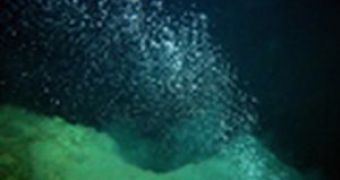In 1990, the Haakon Mosby mud volcano (photo), named in honor of the famous Norwegian oceanographer, was found on the continental slope of the Barents Sea at 1250 m.
This is a flat mud volcano that covers an area of about 1 square km and rises only 10 m above the ocean floor. The volcano emits muds, water and methane from a depth of about 2 km below.
Methane is a greenhouse effect gas 25-times more powerful than carbon dioxide.
There are some specialized bacteria that feed on methane called methanotrophic. A German-French team studied which methanotrophic bacteria could thrive in the ice-cold Arctic deep-sea, at -1?C.
The volcano presents three concentric ring-shaped areas: the center, a zone surrounded by an area of sulphur bacteria and the exterior rim inhabited by tube worms. Usually, methane is used by the organisms living around mud volcanoes from ocean floor to produce food.
In the central region, scientists discovered a new bacterium species that use oxygen to feed on methane. In sediments of the sulphur bacteria region, the team found a new group of methanotrophic Archaea (archaic bacteria) that form a symbiosis with bacteria and use sulphate to oxidize methane, a process called the anaerobic oxidation of methane (AOM).
Surprisingly, the majority of methane was consumed in the tube worm zone, not in the center. Measurements indicated that only 40% of the methane was consumed by bacteria, less than in most methane rich habitats. Until now, the specialists thought that higher fluxes of methane meant greater numbers of methane consuming microorganisms. But at this volcano, very little methane is eaten in the central zone.
The marine biologist Helge Niemann explains this phenomenon: "The methane consuming microorganisms need oxygen or sulphate from the seawater to oxidize methane. In the mud volcano water that flows upwards through the ocean floor both compounds are missing. Since the flow velocity of this water is so high, very little oxygen and sulphate from the seawater can penetrate the ocean floor and therefore the microorganisms in the center and bacteria mat zone just don't get enough energy. At the rim of the volcano, the situation is very different: Tube worms grow about 60 cm deep into the sea floor and actively pump seawater into deeper layers. Microorganisms living at the roots of the worms profit from this situation."

 14 DAY TRIAL //
14 DAY TRIAL //